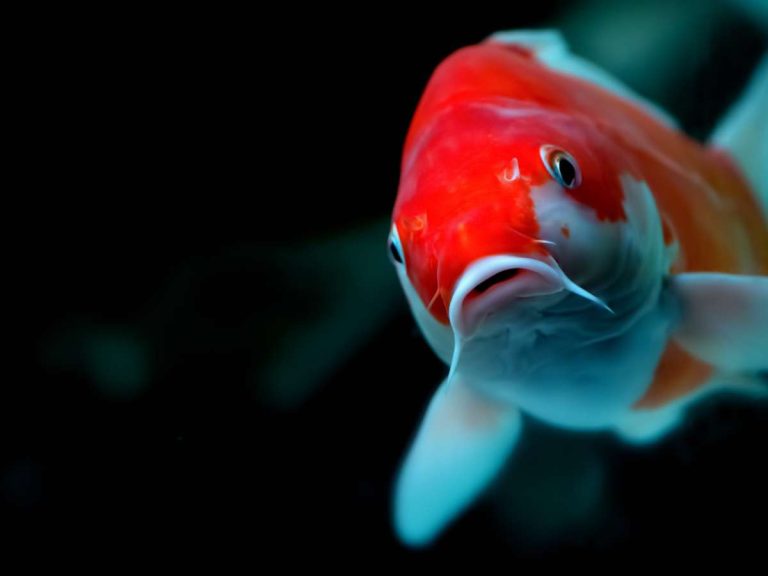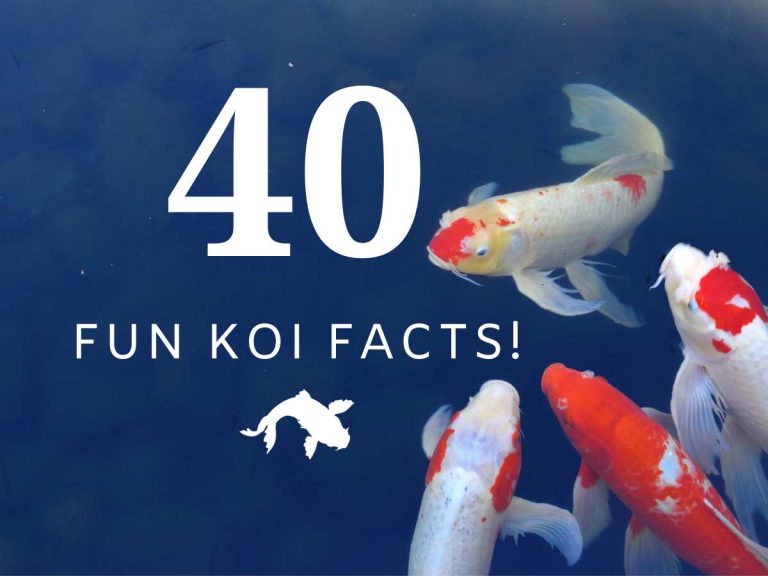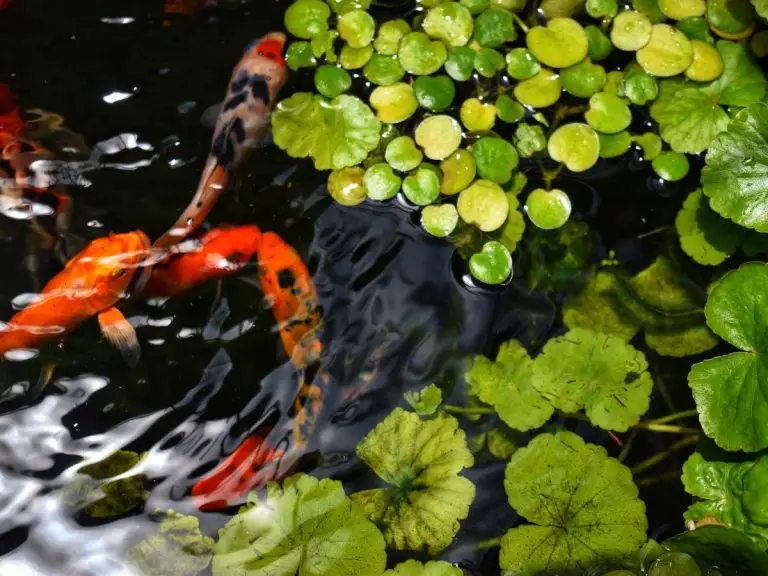How to Tell if Your Koi is Pregnant: Signs to Look for & How to Care for Them
If you’re noticing some physical or behavioral changes in the your Koi and wondering “is my Koi pregnant?”, you’ve come to the right place.
If you suspect that your koi fish might be pregnant, it’s important to look for specific signs and techniques to confirm your suspicions. Understanding the reproductive behavior of koi fish is key to identifying pregnancy in these beautiful creatures.
By keeping an eye out for physical signs, such as an enlarged abdomen, swollen vent area, changes in coloration or patterns, and visible veins on the belly area, you can start to determine if your koi fish is pregnant.
Keep reading to learn more about the fascinating world of Koi reproduction and pregnancy.
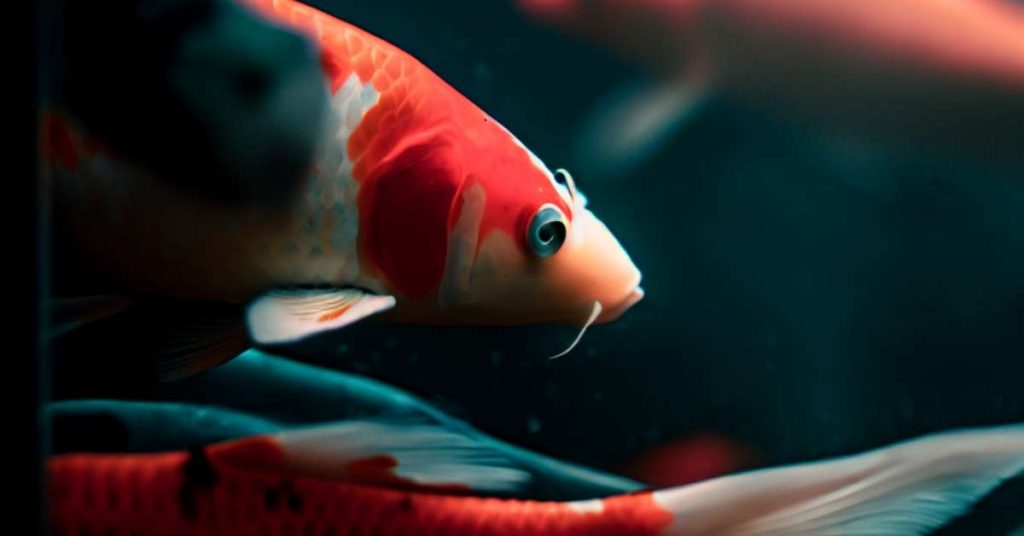
Understanding the reproductive behavior of koi fish
| Category | Key Points |
|---|---|
| Reproductive Behavior | Males court females in spring/summer. Males release sperm; females release eggs. Spawning occurs in shallow, vegetated areas. |
| Factors Influencing Pregnancy | Age: Maturity at 3-4 years. Size: Larger females have higher success. Health: Good water quality, nutrition, and stress-free environment are crucial. |
| Physical Signs of Pregnancy | Enlarged abdomen. Swollen vent area. Changes in coloration or patterns. Visible veins on the belly. |
| Behavioral Signs of Pregnancy | Increased aggression. Nesting behavior. Frequent rubbing against objects (“flashing”). Decreased activity level. |
| Techniques to Confirm Pregnancy | Hormone testing. Ultrasound examination. Observation of spawning behavior. Examination of egg retention in the vent area. |
| Common Misconceptions | All female koi can get pregnant. Confusion between pregnancy and spawning. Koi can get pregnant without males. All physical changes indicate pregnancy. |
| Care for Pregnant Koi | Provide a suitable environment. Adjust feeding habits. Monitor water quality. |
Overview of the reproductive cycle of koi fish
Before we dive into the signs of pregnancy in koi fish, let’s take a moment to understand their reproductive behavior. Koi fish, like many other fish species, have a complex and fascinating reproductive cycle. The process begins with the males actively courting the females, usually during the spring and summer months.
During this period, the male koi fish will chase the female and nudge her abdomen, releasing sperm to fertilize the eggs. The female will then release her eggs and swim over the fertilized eggs, allowing them to attach to her ventral surface. This behavior is known as spawning, and it typically occurs in shallow, well-vegetated areas of the pond.
Once the eggs are attached, the female koi fish becomes responsible for carrying and protecting them until they hatch. This is where we begin to see signs of pregnancy in koi fish.
Explanation of the factors that influence koi fish pregnancy
Several factors can influence how koi fish become pregnant, including age, size, and overall health. Generally, female koi fish reach sexual maturity around the age of three to four years. However, this can vary depending on the individual fish and environmental conditions.
In terms of size, larger female koi fish tend to have a higher chance of producing and carrying eggs successfully. This is because they have more space to accommodate the developing eggs and provide them with the necessary nutrients.
Lastly, the health of the koi fish plays a significant role in determining the success of pregnancy. Good water quality, proper nutrition, and a stress-free environment all contribute to the overall well-being of the fish and increase the chances of a successful pregnancy.
Physical signs of pregnancy in koi fish
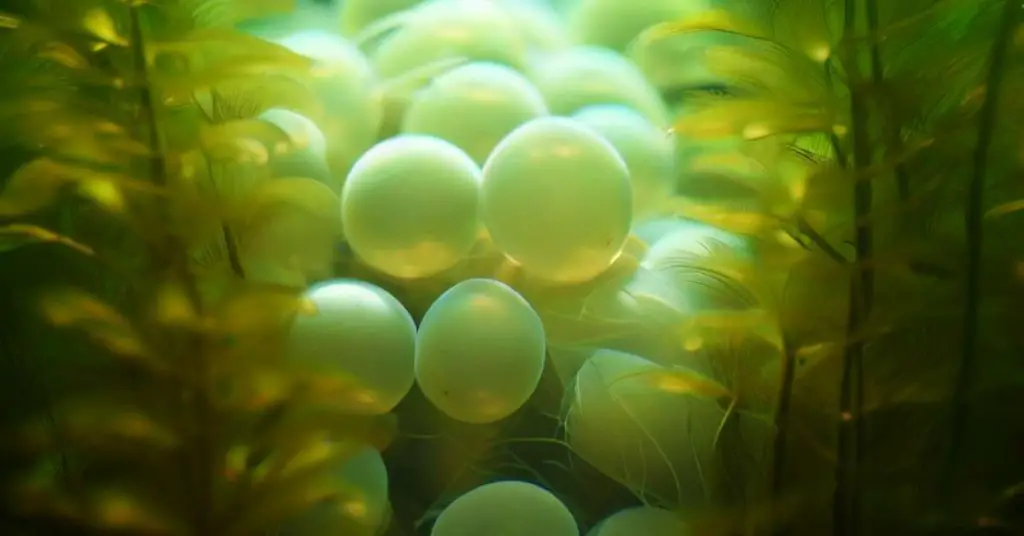
When it comes to determining if your koi fish is pregnant, one of the most reliable indicators is observing the physical changes in their appearance. Here are some key signs to look out for:
Enlarged abdomen
A pregnant koi fish will typically have a visibly larger belly compared to their non-pregnant counterparts. You might notice that their abdomen appears more rounded or bulging. This is a clear indication that eggs are developing inside their body.
Swollen vent area
Another physical sign to watch for is a swollen vent area. The vent, located near the base of the fish’s tail, becomes more prominent and noticeably larger in pregnant koi fish. This swelling is due to the developing eggs being housed in the vent area.
Changes in coloration or patterns
Keep an eye on any changes in your koi fish’s coloration or patterns. Pregnant females may experience a shift in their coloring due to hormonal changes. Some koi fish may develop a darker or more vibrant hue, while others may exhibit a more pronounced pattern on their scales. These color changes can vary significantly from fish to fish.
Visible veins on the belly area
If you inspect the belly of your koi fish, you may notice prominent veins running along the surface. These veins become more visible as the fish’s body prepares for egg development and pregnancy. The increased blood flow necessary to support the growing eggs causes these veins to become more apparent.
Behavioral signs of pregnancy in koi fish
When it comes to determining if your koi fish is pregnant, it’s not just about looking for physical changes. You also need to pay attention to their behavior, as pregnant koi fish display some distinct behavioral signs. Here are a few key things to look out for:
1. Increased aggression
If your normally docile koi fish suddenly starts picking fights with its tank mates, it could be a sign that it’s pregnant. This increased aggression is thought to be a protective instinct, as the pregnant koi becomes more territorial and defensive. So, if you notice your koi fish behaving aggressively towards other fish, it’s worth considering the possibility of pregnancy.
2. Nesting behavior
Just like birds, pregnant koi fish often exhibit nesting behavior in preparation for laying their eggs. This can include digging or rearranging substrate in their tank or pond, creating a safe and suitable environment for their future offspring. Keep an eye out for any unusual digging or nest-building activities, as they are clear indications of possible pregnancy.
3. Frequent rubbing against objects
Pregnant koi fish may also engage in frequent rubbing against objects in their tank or pond. This behavior, known as “flashing,” is believed to help relieve the discomfort caused by the growing eggs inside their bodies. So, if you notice your koi fish rubbing against rocks, plants, or any other objects in their environment more often than usual, it could be a sign of pregnancy.
4. Decreased activity level
One noticeable change in behavior that pregnant koi fish often exhibit is a decrease in their overall activity level. They may become more lethargic and spend more time resting or hiding in shaded areas. This change in behavior is believed to be a result of the physical strain that pregnancy puts on their bodies. So, if you observe your koi fish becoming less active and more prone to resting, it could be a sign that they are carrying eggs.
Techniques to Confirm Koi Fish Pregnancy
When it comes to confirming whether your koi fish is pregnant or not, there are several techniques you can employ. Let’s take a look at a reference table of these techniques:
| Technique | Description |
|---|---|
| Hormone testing | This involves analyzing the hormone levels in the koi fish’s body to determine if pregnancy is present. A veterinarian or fish expert can perform this test. |
| Ultrasound examination | Similar to human pregnancy tests, an ultrasound can be used to visualize the developing eggs inside the fish. A specialized ultrasound machine and a trained professional are needed for this technique. |
| Observation of spawning behavior | While not a foolproof method, observing your koi fish engaging in spawning behavior can indicate that it is pregnant. This includes swimming in a circular motion, nudging against other fish, and chasing after males. |
| Examination of egg retention in the vent area | By gently palpating the vent area, you may be able to feel the presence of eggs. Be cautious and seek guidance from an expert before attempting this technique. It’s essential not to injure the fish. |
Remember, accuracy may vary with each technique, and it’s always best to consult with a professional or someone experienced in koi fish breeding to obtain more reliable results. Consider utilizing a combination of these techniques for a more comprehensive assessment of koi fish pregnancy.
Common misconceptions about koi fish pregnancy
When it comes to koi fish pregnancy, there are several common misconceptions that can lead to confusion. Let’s debunk these myths and provide some accurate explanations:
Misconception 1: All female koi fish can get pregnant.
Explanation: While it’s true that female koi fish have the potential to reproduce, not all of them will get pregnant. Just like in any species, there is a specific reproductive cycle and conditions that need to be met for successful fertilization.
Misconception 2: Confusion between pregnancy and spawning behavior.
Explanation: The behaviors associated with koi fish pregnancy may sometimes be mistaken for spawning behavior. It’s important to understand the difference. Spawning behavior refers to the act of laying and fertilizing eggs, whereas pregnancy refers to the period of carrying and developing fertilized eggs inside the female koi fish.
Misconception 3: Koi fish can get pregnant without the presence of male fish.
Explanation: In order for female koi fish to become pregnant, there needs to be a male fish present for fertilization. The male fish will release sperm, which will then fertilize the eggs laid by the female. Without the male fish, pregnancy cannot occur.
Misconception 4: All physical changes in a female koi fish indicate pregnancy.
Explanation: While physical changes can be an indicator of pregnancy, they may also be caused by other factors such as illness, stress, or environmental conditions. It’s essential to consider multiple signs and symptoms to accurately determine if a koi fish is pregnant.
Taking care of a pregnant koi fish: Tips & Suggestions
1. Providing a suitable environment:
Make sure your pregnant koi fish has a spacious and well-maintained pond to live in. Adequate space is essential for her to swim comfortably and avoid stress.
Additionally, ensure that the water temperature and quality are optimal for her health and the development of her eggs. This includes regular testing and monitoring of pH levels, ammonia, and nitrate levels.
2. Adjusting feeding habits:
During pregnancy, it’s important to adjust your pregnant koi fish’s feeding habits. Increase the amount of food you provide, but be careful not to overfeed her. Overfeeding can lead to health issues and water contamination.
Choose a high-quality koi fish food that provides the necessary nutrients for her and her developing eggs. It’s also a good idea to supplement her diet with fresh vegetables and fruits for additional vitamins and minerals.
| Koi Food | What To Remember |
|---|---|
| Dietary Needs | Pregnant koi require a balanced diet rich in proteins, vitamins, and minerals to support the development of eggs and maintain overall health. |
| Type of Food | – High-quality koi pellets: Ensure they are specifically formulated for breeding or pregnant koi.<br>- Fresh vegetables and fruits: Such as lettuce, watermelon, and oranges for added vitamins and minerals. |
| Frequency of Feeding | Feed 2-3 times a day in smaller quantities. Overfeeding can lead to water contamination and health issues. |
| Amount of Food | Pregnant koi may eat more than usual. However, avoid overfeeding. Offer what they can consume in about 5 minutes. Remove any uneaten food to maintain water quality. |
| Water Temperature | The metabolism of koi is influenced by water temperature. In warmer temperatures (above 68°F or 20°C), koi are more active and require more food. In cooler temperatures, reduce the amount of food. |
| Supplements | Consider adding vitamin and mineral supplements to support the health of the pregnant koi and the developing eggs. |
| Observation | Monitor the koi’s behavior. If she is leaving food uneaten, consider reducing the amount. If she seems hungrier, slightly increase the portion. Always ensure the food is fresh and free from mold or contaminants. |
| Water Quality | Maintain optimal water quality. Regularly check pH, ammonia, nitrite, and nitrate levels. Clean water ensures better food absorption and overall health of the pregnant koi. |
| Avoid Stress | Stress can affect the appetite of pregnant koi. Ensure a peaceful environment, avoid sudden changes in water parameters, and minimize disturbances around the pond. |
3. Monitoring water quality:
Pregnant koi fish are more sensitive to changes in water quality, so it’s crucial to maintain excellent water conditions. Regularly test the water parameters and perform water changes as needed to ensure a clean and healthy environment.
Avoid using any chemicals or medications that may harm the pregnant koi fish or her unborn fry. If you notice any signs of illness or abnormalities, consult a professional for guidance on appropriate treatment options.
Conclusion
In conclusion, determining if a koi fish is pregnant requires careful observation of both physical and behavioral signs. By understanding the reproductive behavior of koi fish and recognizing the physical changes that occur during pregnancy, you can successfully identify pregnant koi fish in your pond.
Some of the main physical signs to look out for include an enlarged abdomen, swollen vent area, changes in coloration or patterns, and visible veins on the belly area. Additionally, pregnant koi fish may exhibit behavioral changes such as increased aggression, nesting behavior, frequent rubbing against objects, and decreased activity level.
To confirm koi fish pregnancy, various techniques can be used, including hormone testing, ultrasound examination, observation of spawning behavior, and examination of egg retention in the vent area. It is important to note that not all female koi fish can get pregnant, and the presence of spawning behavior does not necessarily indicate pregnancy.
When caring for a pregnant koi fish, providing a suitable environment, adjusting feeding habits, and monitoring water quality are essential. Ensuring optimal conditions for the pregnant koi fish will help promote a healthy pregnancy and increase the chances of successful reproduction.
In summary, observing the physical and behavioral signs, using appropriate techniques to confirm pregnancy, and taking proper care of the pregnant koi fish are crucial steps in successfully raising and breeding koi fish. Remember to seek professional advice and continue researching to ensure accurate identification of koi fish pregnancy and to maintain the overall health and well-being of your koi fish population.
Main Facts Covered in the Article:
- Understanding the reproductive behavior of koi fish
- Physical signs of pregnancy in koi fish
- Behavioral signs of pregnancy in koi fish
- Techniques to confirm koi fish pregnancy
- Common misconceptions about koi fish pregnancy
- Taking care of a pregnant koi fish
Related Questions
Can male koi fish become pregnant?
No, male koi fish do not become pregnant. Only female koi fish have the ability to carry and lay eggs.
How long does koi fish pregnancy last?
Koi fish pregnancy is not like human pregnancy. It is actually known as “egg retention” and typically lasts for a few weeks to a couple of months, depending on various factors such as water temperature and the health of the fish.




